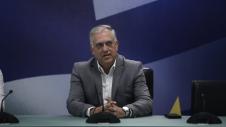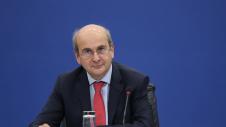The Greek economy will show its best investment performance since 2010 in 2024, with a catalytic contribution from the Recovery Fund. Investment will be the main factor supporting the increase in growth to 3%, while the state budget is entering an austerity phase and will have a negative contribution to GDP next year.
As the text of the draft budget for 2024 sent by the government to Brussels shows, a new balance is being created next year in economic policy. Growth will be strongly supported by the Recovery Fund, which will bring subsidies equivalent to 1.8% of GDP (from 0.8% in 2023) and cheap loans equivalent to 1.5% of GDP (from 0.9% in 2023) to the economy in 2024. This boost to investment will allow growth to rise from 2.3% this year to 3%, despite the fact that fiscal measures in 2024 will move towards austerity.
In 2024 the country will be able to significantly reduce the gap with the euro area in investment. As the draft states,
- Greece's net fixed capital stock has been suffering losses since 2011, but is expected to recover quickly, mainly through the implementation of the 'Greece 2.0' programme. The projections for nominal net investment are positive for the Greek economy in 2024. The gap in real gross fixed capital formation as a percentage of GDP from the euro area average is expected to narrow below 6% for the first time since 2010 (to 5.7%, as illustrated in the figure).
- The contribution of the Recovery and Resilience Fund to GDP growth is expected to reach 1.7 percentage points in 2024, revised upwards by 0.1% compared to the 2023 Stability Programme. The annual growth rate of real investment is expected to accelerate to 12.1 percent in 2024 compared to 2023, mainly driven by higher rates of investment in equipment and non-residential construction.
At the same time, fiscal policy will become restrictive in 2024, as the government is required to run a primary surplus above 2% of GDP and implement the Commission's policy recommendations. As shown in the table, in 2022 fiscal measures added 0.9% to GDP, in 2023 they added 0.1%, while in 2024 they will subtract 0.3% from the economy's output.
One of the most important sources of savings will be the reduction of energy support measures. As the General Accounting Office notes in the draft budget, energy crisis support measures were significantly reduced in 2023, while the vast majority of these measures are planned to be phased out in 2024, and any targeted subsidies will be fully covered by revenues from the Energy Transition Fund.
For 2024, the general government deficit is projected to be significantly reduced to 1% of GDP, down from 2.1% in 2023. The primary surplus is expected to increase to 2.1% of GDP in 2024 from 1.1% in 2023. The projected increase in national net primary expenditure is very small and certainly below the 2.6% ceiling recommended for Greece by the European Council.
The key role of Recovery Fund
The catalytic contribution of the Recovery Fund to maintaining strong growth in Greece, at a time of a slowdown in the European economy and a return to tighter fiscal policy, is made clear by the relevant chapter of the draft budget submitted to Brussels.
As highlighted, among other things,
- The National Recovery and Resilience Plan (NRP), "Greece 2.0", aspires to change the existing economic model and institutional framework through a variety of reforms and investments, leading the Greek economy towards a more outward-looking, competitive, green and digital growth model, with a more resilient social safety net.
- The initial resources included in the "Greece 2.0" programme for the period 2021-2026 amount to €30.5 billion, of which grants are estimated at €17.8 billion and loans at €12.7 billion to support investments and reforms.
- Greece submitted a proposal for a revision of its NDS on 31 August, which includes a request for additional loans of €5 billion, an increase in the budget of the existing loan facility and a capital increase for REPOWER EU with measures amounting to €795 million in grants. With the adoption of the revision, the resources will amount to EUR 36 billion in grants and loans.
- As of 10 October 2023, EUR 3.74 billion was transferred for approved RRF projects to entities within and outside the general government and RRF final recipients. 718 projects and sub-projects, with a total budget of EUR 20.7 billion, including VAT, have already been approved and included in the grant programme.
- The approved projects include, among others: energy renovation of residential buildings, energy upgrading of public sector buildings, island electricity interconnections, energy storage investments, motorway construction, microsatellite network development, implementation of the national secondary prevention public health programme, implementation of the strategy of excellence in universities and innovation and many others.
- In April 2022, Greece received the first payment for 2022 from the Recovery and Resilience Fund of €3.6 billion, after meeting 15 milestones. In January 2023, Greece received the second payment request from the Recovery and Resilience Mechanism of EUR 3.6 billion, after meeting 28 milestones. In 2023 Greece submitted the 3rd payment request of €1.72 billion for grants, having completed 42 milestones and targets, which is currently under assessment by the European Commission.
- On the loan component, the plan includes the use of loans of up to €12.7 billion and is expected to mobilise a total of €32 billion of investment resources to co-finance projects falling under the following five pillars: green transition, digital transition, exports, innovation-research and development, economies of scale through partnerships, joint ventures, acquisitions, mergers.
- In the Loan Facility, which mainly concerns the provision of loans for the implementation of investment projects by private companies through commercial banks and international financial institutions, the situation between projects submitted and loans signed - until 10 October 2023 - was as follows: 536 investment projects with a total budget of EUR 19.98 billion have been submitted (of which: EUR 8.17 billion of RRF loans, EUR 6.92 billion of bank loans and EUR 4.89 billion of investors' own participation). 240 loan agreements have already been signed, with a total budget of EUR 8,51 billion (of which: EUR 3,52 billion RRF loans, EUR 2,92 billion bank loans and EUR 2,07 billion equity participation of investors).









